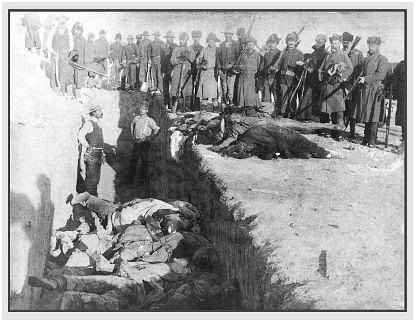
Burying the dead in mass graves at Wounded Knee
Word spread
quickly that Sitting Bull had been killed. Hearing this news
prompted another Sioux chief, Big Foot, to move his small band to a
more protected and remote area on the Pine Ridge reservation in
South Dakota. Army troops that had been given orders to put
an end to the Ghost Dance among the plains tribes, were on patrol
in the area when Big Foot's band began its march.

Members of the 7th Cavalry attacked Big Foot's band of
Sioux ghost dancers in retaliation for Sitting Bull's humiliating
defeat of George Armstrong Custer at the Battle of the Little Big
Horn, fourteen years earlier. At Wounded Knee, the soldiers
used four semi-automatic Hotchkiss guns to massacre an encampment
of mostly women, children, and old people. It would be regarded as
the last 'battle' in the 19th century Indian Wars. Here, one
of the victims lay frozen in death's haunting repose on the
battlefield.
click here for more
Big Foot, who
was sick with pneumonia, flew a white flag of peace from his wagon,
and readily surrendered when his band encountered the mounted
troops. The weather was bitterly cold. He agreed
to have his warrior surrender as well before traveling on, and when
the troops arrived in the morning to collect weapons from the
warriors, a gun discharged during an altercation and 500 troops
opened indiscriminate fire with four howitzers and rifles into the
center of the encampment, which was mostly women, children, and old
people. One hundred and forty-six defenseless Indians were
killed, and another fifty-one were seriously wounded.
Among them was a young boy who would become famous as a spiritual
leader named Black Elk.
click here for more
This was the
last 'Indian battle' of the Indian Wars on the
Plains.